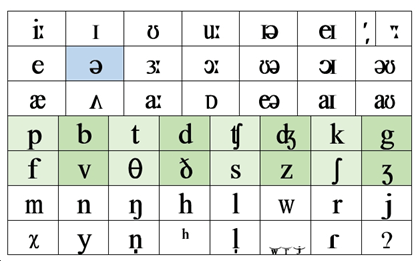By Steve Hirschhorn
The International Phonetic Alphabet (IPA) is the result of work by 19th and early 20th century phoneticians such as Henry Sweet, Otto Jesperson and later Daniel Jones to create a visual taxonomy of human speech sounds. Each sound is represented by a symbol with additional symbols for adjusting sounds to show or represent, for example, nasality.
The IPA can be used to show how an utterance can be sounded or how an utterance actually has been sounded in a specific example. For our purposes, we’ll focus on the notion of showing how something might be pronounced because that’s where language teachers and students will find the most benefit. So, the IPA is a tool, often in the form of a chart (see fig 1), which teachers and students can use to guide pronunciation.

This chart, based on Adrian Underhill’s well-known chart and using my own IPA font, represents the sounds of English; there are other symbols which apply to other languages.
<
Let’s start by examining one of the major objections to using the IPA: it is said to represent a prestigious variety of English known as Received Pronunciation and therefore doesn’t represent “my” accent or “my” variety of the language. The chart above is a simple graphic denotation of phonemes, or sounds. Phonemes, it can be argued, are an imaginary concept given that we all pronounce sounds slightly differently since our articulatory equipment is slightly different, just as our faces are slightly different.
The phoneme doesn’t really exist, it’s just an idea so I, as a teacher, can invest the symbols of the chart above with almost any sounds I choose! Of course I can only do that within reason; this means, investing /t/ with the sound /n/ would be clearly absurd but a variation of a vowel sound or a consonant to account for regional accent is completely fine. So we can use the IPA to show sounds from whatever accent or variety we choose.
And now, to some advantages!
Most of us these days will be working towards a student-centred classroom in which teacher becomes a guide or facilitator to support students in their learning rather than the somewhat old fashioned idea of teacher as ‘giver of information’. As a guide then, we can expect to offer useful information which will enable students to arrive at their own conclusions within certain parameters. What I mean by this is that the information we provide will allow students to find a pathway to their own learning rather than simply to listen to the teacher and follow mindlessly. The same principles apply in teaching pronunciation. We know these days that no variety of English has automatic primacy and therefore we no longer drill students to try to reach some sort of native-like reproduction but rather, we work towards intelligibility.
The IPA chart then, is a way to challenge students to ‘discover’ the pronunciation of items, not necessarily single words but also connected speech through using an internal model combined with the teacher’s guidance. Most teachers who use a chart, also use a pointer of some sort for practical reasons of visibility and also, perhaps on a slightly more esoteric note, to distance oneself from the language, as Caleb Gattegno suggested.
This being the case, pronunciation can be shown simply by pointing out the item needed, not saying anything at all but encouraging students to invest in their own learning by accepting the challenge to work it out.
In my experience of using a chart for the last 40 years or so, students love the challenge of doing that rather than simply ‘listen and repeat’.
As well as the chart itself, teachers can also use the IPA for a variety of additional purposes, amongst them: giving written instructions, setting homework tasks, jigsaw sentences in IPA, having students write notes to each other in IPA and writing classroom information such as ‘rules’ and so on. Indeed, the number of uses for the IPA is determined only by the imagination of the teacher and students!
But first, of course, students need to know what those squiggly symbols stand for!
There are many IPA charts around with words underneath each symbol to epitomise the sound represented by the symbol but personally, I don’t like those.
Let’s imagine that a student sees this:
“/i:/ sheep” but the student’s L1 doesn’t contain that long ‘ee’ sound. Our students then will probably attach the nearest available sound to that symbol and that sound will almost certainly be /I/ meaning that from here on, ‘sheep’ will be pronounced ‘ship’ and so on. Not a disaster, I hear you say but this lack of differentiation could affect intelligibility as could other examples of words being misinterpreted through having been linked to L1 sounds rather than L2 sounds.
So I don’t use those lists but instead, I use techniques which originated in the practice of Silent Way, by showing how the sounds are produced, silently! Teacher points at a sound and mouths and gestures so that students can produce the sound. Then the teacher either accepts their production or indicates how they need to adjust it.
This process is simpler than it sounds here and much easier to show than to describe in words! I have used this technique with students of all ages and L1s and also with hearing impaired students. As a matter or interest, I’ll be demonstrating this technique at EdYOUfest 2019 in Street, Somerset, so come along if you’d like a practical view of how all of this works!






